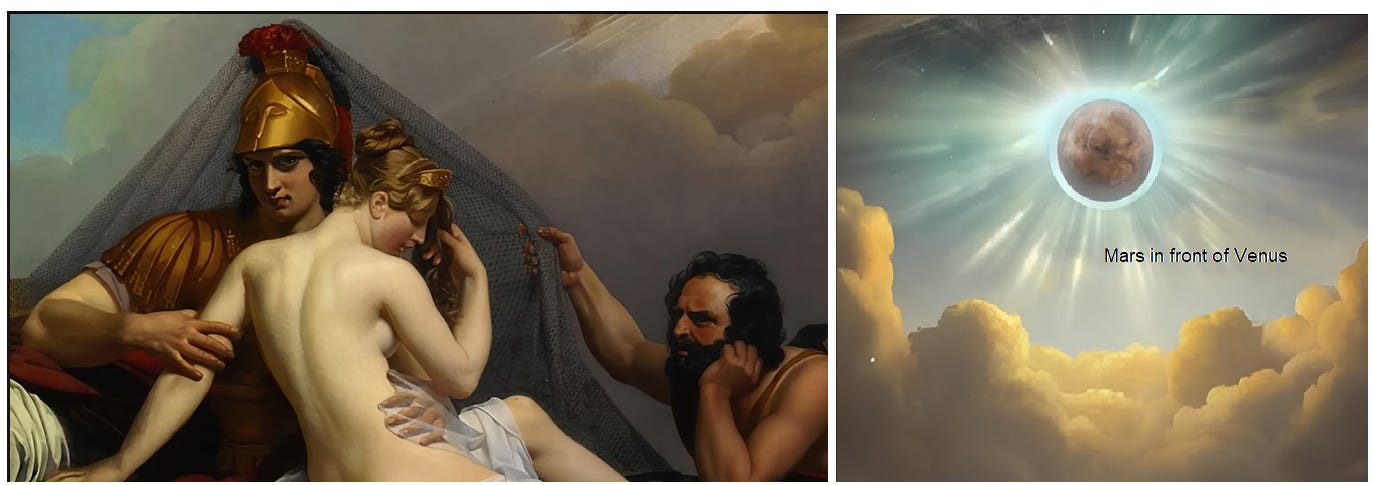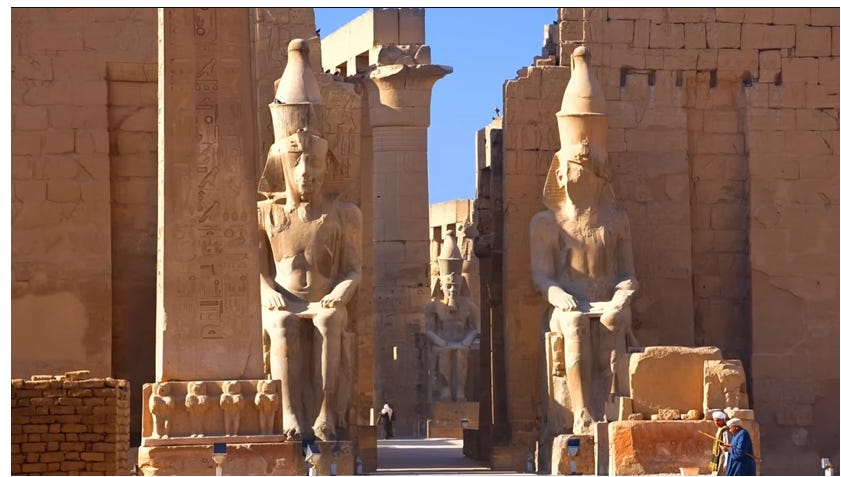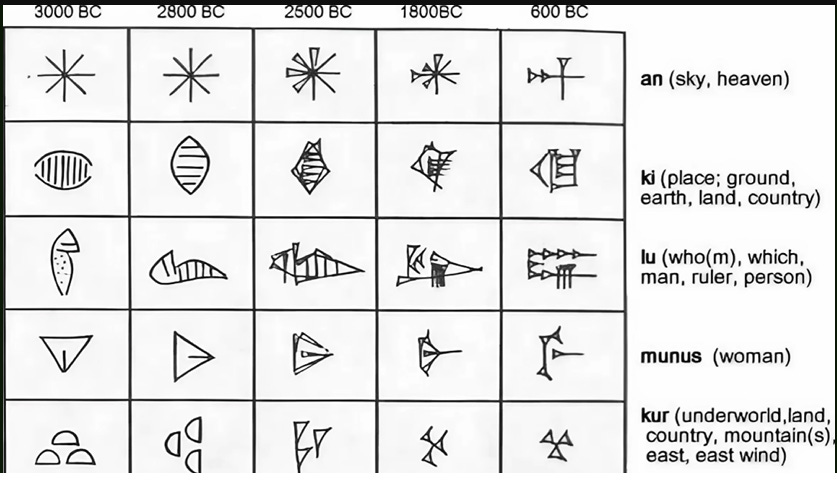This is a transcript of Ev Cochrane's recent video, "Ev Cochrane: Turquoise Sun – Chronicle of Creation" at youtube.com/watch?v=N1jc4lOCtK4
THE REAL SOLAR SYSTEM HISTORY
My most recent book, The Case of the Turquoise Son, summarizes nearly a half century's worth of research in ancient myth and archeoastronomy. Our primary findings include the following basic proposition.
_1. The first gods were the planets, pure and simple.
_2. Myths of creation, inasmuch as they describe the deeds of the gods in ordering the cosmos, are best understood as eyewitness accounts describing extraordinary cataclysmic events involving the respective planets moving in close proximity to Earth and giving rise to the principle structures of the celestial landscape: Ladder to Heaven; the World Tree; the Luminous City on a Hill; etcetera.
_3. The earliest cosmogonic myths of Mesopotamia, Egypt and Mesoamerica encode the explosive birth of the turquoise sun, a sun which is clearly distinguishable from the present sun.
_4. The Queen of Heaven, referenced in the Old Testament and countless other ancient texts around the globe, is to be identified with the planet Venus.
_5. The warrior hero, represented by such familiar figures as Heracles, Gilgamesh, Samson, Cuchulainn and Batraz, is to be identified with the planet Mars.
_6. The global myth of the Sacred Marriage most familiar in Homer's account of the torrid love affair between Aphrodite and Aries, describes a close conjunction, or union, of Venus and Mars.
_7. The origin of the primary institutions of human civilization, science, religion, philosophy, monumental architecture, drama, dance, music, sports, marriage, ritual, etcetera, is firmly rooted in the catastrophic events involving the respective planets.
_And to complete the basic propositions, here's #8. The history of the solar system recounted in modern textbooks is utterly wrongheaded and divorced from reality.
_This is the initial episode of a series based on the Turquoise Sun. In the forthcoming episodes, I will present evidence in favor of each of these propositions. Suffice it to say that proper documentation is to be found in my latest book, The Case of the Turquoise Son, A Natural History of Creation, and within my entire collection of published material beginning with the Aeon Journal in 1988.
THE SATURN-SUN FIRST APPEARED TURQUOISE
The basic plot of the case of the Turquoise Sun revolves around the claim that the earliest remembered sun and human tradition presented a brilliant turquoise form at the time of creation.
The Book of the Dead includes the following account. Quote: When thou appearest in the horizon of heaven, hymns to thee are in the mouths of everyone, thou being beautiful and youthful in the sun disk within the arms of thy mother, Hathor. How thou shinest in every place, thy heart rejoicing forever. How thy shinest in the horizon of heaven. Thou hast strewn the Two Lands with turquoise. End of quote.
The primal sun was elsewhere described as a sun of turquoise. Indeed, as Jan Zandee pointed out in his commentary on this hymn, turquoise was deemed to be the very substance of which the sun was composed. The cult of the sun reached its greatest heights during the New Kingdom, roughly 1500 to 1200 BCE. Quote: Hail to you who rises in turquoise, reads one solar hymn. Such imagery is so commonplace in the solar hymns that Egyptologists readily concede the point, even though it stands in stark contradiction to empirical reality. Joris Bourghouts emphasizes the point. Quote: In certain hymns the sun is said to strew the sky with turquoise. End of quote. What is true in ancient Egypt is also true in Meso-America.
Thus it is that the Aztecs referred to the Sun god by such epithets as Turquoise Child and Turquoise Prince. Although analogous traditions are to be found around the globe, they have never garnered serious attention from scholars.
PLANETS WERE THE FIRST GODS
That the planets were the first gods, while controversial at first sight, is readily demonstrable upon a critical analysis of the relevant evidence. In the earliest writing system of Summer, for example, the concept of god was represented by the sign of a star. Already in the fourth millennium BCE, Sumer's greatest goddess is explicitly identified with planet Venus. What is true of ancient Mesopotamia is also true of Egypt, where the leading god, Horus, is explicitly identified with prominent star and pictographs dating to 3000 BCE. So too, in the earliest Indo-European pantheon, the supreme god, Zeus, and his various cognates in other languages, is explicitly identified as being celestial in nature. The name Zeus, for example, derives from the Indo-European route "tiu" and denotes sun, sky, light. Simply stated, the earliest gods of which we have any knowledge could be securely identified with material bodies in the sky overhead, i.e., the stars and planets.
TUMULT IN THE ANCIENT SKIES
The earliest extant literature to be found anywhere on Earth describes the gods as celestial agents. Sumerian hymns describing the goddess Inanna described her as a towering planet filling the sky. Quote: She who fills heaven and earth with her huge brilliance. End of quote. The same goddess is elsewhere described as a holy torch who fills the heavens. So too, in text from the third millennium BCE, the Egyptian god, Horus, is described as a fiery star who implanted himself within the womb of Isis. The pyramid text invokes the star god as follows. Quote: There is tumult in the sky. 'We see something new', say the primeval gods. O you Aennead, Horus is in the sunlight. The king takes possession of the sky. He cleaves its iron. End of quote. Evident in the Mesopotamian and Egyptian texts alike is the fact that the epiphany of the great gods is something that takes place in the skies overhead and is of a tumultuous, catastrophic nature, marked by the shaking of heaven and earth, prodigious amounts of lightning and earth-splitting thunder.
TUMULTUOUS SATURN-SUNRISE
This is nowhere better illustrated than in ancient descriptions of sunrise, which speak of it as being marked by the shaking of heaven and earth. Of the numerous texts that could be cited in this regard, the following Sumerian, hymn the Sun god is representative in nature. Quote: As my King comes forth, the heavens tremble before him, and the earth shakes before him. End of quote. Elsewhere in the same hymn, Utu is described as follows. Quote: The Lord, the son of Ningal, thunders over the mountains like a storm. {End quote.} Now I ask, does this sound like a realistic description of modern experience of sunrise? In what sense is the solar epiphany ever accompanied by thunder, or the shaking of heaven and earth? Here too, the evidence of ancient language corroborates testimony of the earliest written texts, with regards to the inherent relationship between the primal sun and lightning. Thus it is that, around the globe, languages identify the sun as a locus of lightning or storm. The Sumerian logogram UD, for example, denotes sun, yet the same logogram denotes storm and constitutes a traditional epithet of the archaic Thunder god. The same anomaly is to be found in the ancient Semitic language, where Umu denotes sun, as well as storm. So too in Meso-America the proto-Maya term K'uuh denotes sun, god, divinity, while the cognate k'uh denotes lightning, thunderbolt.
SATURN-SUN’S ELECTRICAL ACTIVITY
Encoded in such archaic terminology is the historical fact, the primal sun was a locus of intense electrical activity, likely plasma-based in nature, as per the theories of Anthony Pratt and Wal Thornhill. Early artworks allegedly depicting the sun are equally difficult to square with the familiar solar orb. These figures include three different so-called solar images commonly depicted on Mesopotamian cylinder seals. It will be evident at once that not one of them bears any resemblance to the familiar sun. The current sun does not appear in the crescent, for example, nor does it typically reveal a star-like form in its center. Now consider the image depicted in this figure, a close variation on the previous image, representing an earlier phase in the evolutionary history of the polar configuration, in which fiery lightning-like filaments radiate across the disc of the sun. In our view, the global traditions of lightning discharging sun, or solar eye likely find their origin here. An old Babylonian hymn provides an archaic example of this idea. Quote: May Utu at his rising from his chamber, gaze with his favourable eye towards it. My king raised his head toward heaven. There may everyone praise him together, when he raises his eyes flashing like lightning. End of quote. Analogous traditions will be found seemingly everywhere. The very same idea appears among the indigenous tribes of the Amazonian jungle. Quote: Lightning is also interpreted as a glance from the sun, a rapid twinkle. End of quote. So too it will be remembered that Zeus's eye cast forth the Thunderbolt in Greek tradition.
SUMMARY
To summarize, the evidence of the ancient literary text, artworks and language speaks with one voice in telling of a radically different sun prevailing in the relatively recent prehistoric past. It is at this point that the informed reader is confronted with certain fundamental questions of logic and common sense. At what point does the evidence become too compelling to be ignored? At what point can we expect a fruitful interface of ancient myth and modern science? In a recent discussion of scientific methodology, the astronomer John Steele pointed out the decisive role planetary observations have played in the development of the respective physical and mathematical sciences. It was the Babylonian planetary observations, after all, that Ptolemy drew upon in order to place Greek astronomy and mathematics on a secure scientific foundation, after which the new science spread to India, China, Egypt and the four corners of the globe. Steele offered the following important observation. Quote. Astronomy always has been and still is a science that relies on the use of past observations. Unlike most sciences, astronomy can never be truly experimental. Astronomers can only observe the astronomical phenomena that present themselves, perhaps uniquely in the sciences. Astronomers therefore, are forced to rely upon empirical data collected by their predecessors. End of quote. Yet, as we have documented in the case of the Turquoise Sun, in other words, modern astronomers have almost uniformly ignored the astronomical observations included in ancient literary text, pictographs and artworks. They do so at their own peril. For what could be more revolutionary than the possibility that a wholly different Sun dominated the sky in the relatively recent prehistoric past?
















